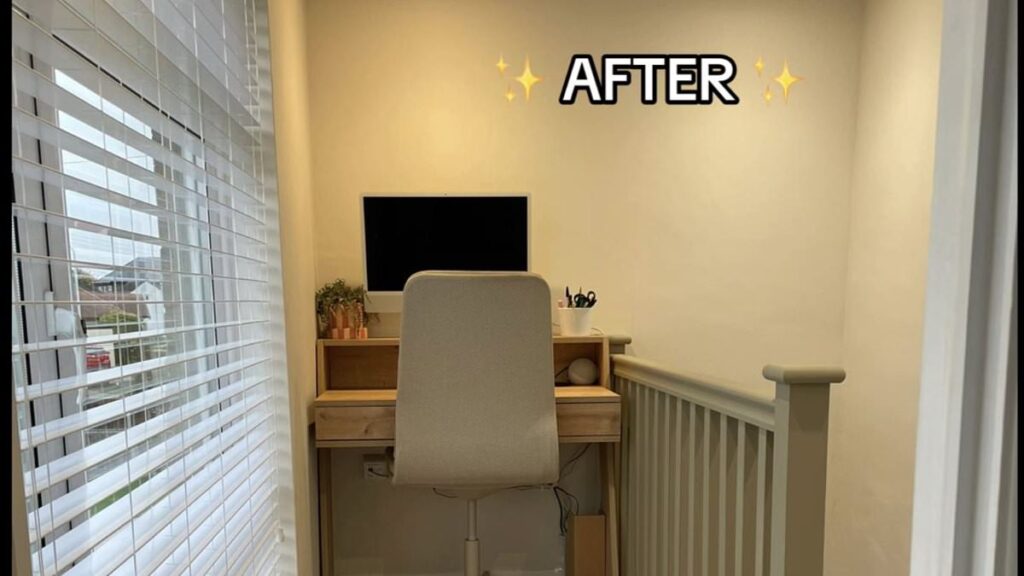A savvy woman has revealed how she’s transformed the empty space above her stairs into a tiny home office for £3,000.
Emily McAllister, from London, has taken to her TikTok account to document her first home renovations and many are impressed with her home office transformation.
Sharing a before and after clip, which gained over one million views, Emily showed her simple yet effective design, featuring a platform above the stairs in the landing.
She previously had stairs that spiralled down to her front door, but took up a huge part of her hallway, so instead, she got builders to add a raised platform along her hallway.
Emily bought a £80 B&Q desk in a natural oak colour, which was just enough room for her keyboard and monitor.
Next she purchased an IKEA MULLFJÄLLET desk chair for £150, cream carpet from Tapi and she used a natural green paint colour from Frenchic Paint for the banister to finish off the look.
She revealed in the comments that the project cost her between £2,800 and £3,000 with materials.
Emily wrote: ‘Swipe to build our home office. Obsessed with our little office!!! Proof that no space is too small to be useful.’

Emily McAllister, from London, transformed the empty space at the top of her stairs into a tiny home office for £3,000
People were amazed at the transformation and were quick to praise her space-saving idea.
One person wrote: ‘This is such a creative way to use wasted space! Love it.’ Another said: ‘£2800-3000 with materials!.’
Meanwhile, someone else added: ‘This is gorgeous and such an innovative use of the space.’
However, others were nervous that they would drop items down the stairs when working. One person wrote: ‘I’d be dropping all papers and pens down the stairs knowing me.’
Another said: ‘I’d roll back when I’m fuming about something and I’d go flying down the stairs.’
Someone else said: ‘Can you imagine knocking something over and it falls down the stairs and you having to go fetch it.’
To which Emily replied: ‘We’ve been working here about 2/3 months now and that hasn’t happened so I think we’re good haha!’
It comes after another savvy remote worker revealed how he replaced his run-down shed with a luxury home office he built from scratch.

Sharing a before and after clip of the new DIY office, Emily showed her simple yet effective design idea by building a platform above the stairs in the landing

She previously had stairs that spiralled down to her front door, but took up a huge part of her hallway, so instead, she got builders to add a raised platform along her hallway



People were amazed at the transformation and were quick to praise her space-saving idea




However, others were nervous that they would drop items down the stairs when working
Jonathan Bradley, 57, from Kent, who runs online business seminars, spent three months constructing the impressive back garden structure, which boasts built-in shelving and sleek glass doors.
He saved money by buying material second hand and doing most of the work himself, despite his limited experience.
Jonathan was able to complete the project for £6,000, compared to the £15,000-£20,000 he estimates professionals would have charged for similar work.
‘Up until lockdown, my business was thriving,’ Jonathan explained. ‘I was running workshops for business leaders across the world. Suddenly my business model wasn’t going to work and it was a bit of a shock.’
‘I had clients who were happy to do webinars and things online but trying to work with dogs barking, teenagers and things like the postman at the door was difficult.
‘I was out in the garden looking at the knackered old shed that you couldn’t swing a cat in and I knew that wasn’t going to work.

Before, there was a little shed at the back of Jonathan’s garden, pictured, but he removed it and cleaned the surface in order to build his own, larger shed. Jonathan explained the original structure (above) wasn’t ‘big enough to swing a cat in’

The finished result is stunning, with insulation in the walls, floor and ceiling making the garden office cosy even in winter. The entrepreneur was able to design the space to fit his needs and added in a built-in bookcase and separate seating area
‘I started designing it on a piece of paper and knew that I couldn’t afford to get someone to come and build it, so just had to do it myself.’
Although the dad had some experience with basic DIY, he had never built something from scratch before or taken on a big project.
Jonathan started by creating a level area as the garden was at different heights. With limited tools, he turned to the kitchen for inspiration.
He said: ‘I got some cake tins and filled them with concrete to build up the difference in height between each side. They were the springform ones where you can unclip the sides. Once I’d done that, I put joists in and then put a big chunk of ply on top for the floor.’
Although he had to buy new materials like plasterboard and insulation, Jonathan was determined to use as much recycled material as possible to keep costs low.
He said: ‘I found things like the doors and windows on Facebook Marketplace. The back window was one someone was throwing out and I got it for £20.’










